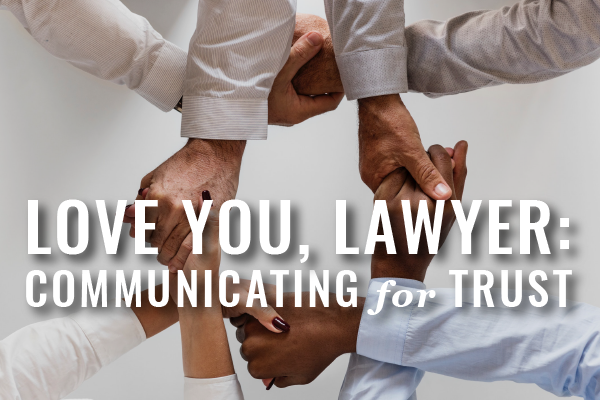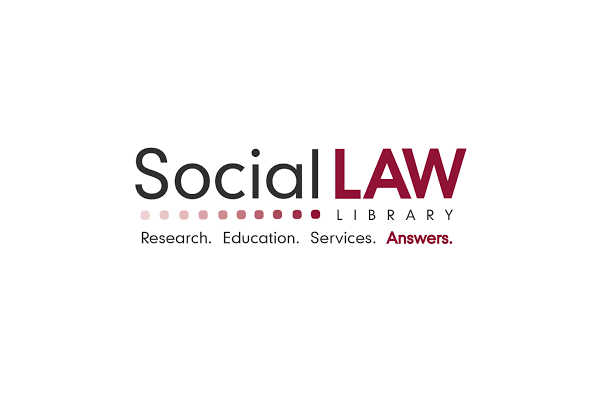November 2 is Love Your Lawyer Day! Celebrate by developing the communication skills you need to create the trust you need for a healthier life and law practice.
Lawyers are in the business of selling their ideas. They sell prospective clients on the idea to hire them and clients on the idea to heed their advice. They sell colleagues on ideas for running the business and working together.
Selling tends to be easier and more successful when we sell to people who like and trust us. If you want to be liked and trusted, you may need to adjust not just what you say, but also how you communicate.
Initial impressions matter; however, whether someone will decide to like, trust and be sold on your idea depends on your communication style. A style that effectively sells your idea to one person may not be as effective on the next person.
INITIAL IMPRESSION AND GENERAL RULES
Generally, people tend to like and trust those they perceive as attractive and trustworthy. But what makes someone decide that someone else is attractive and trustworthy? Often, it’s a matter of first impression.
In a formal presentation, before you say anything, standing up straight with head tilted slightly upwards and arms akimbo generally will be perceived as an indicator of your attractiveness and trustworthiness, as will be limiting prolonged, direct eye contact. People tend to conclude that someone is less trustworthy if they appear fatigued or impulsive, cross their arms, lean away, or touch their faces or hands. Body language does, indeed, communicate likability and trust more than words.
People also tend to like and trust other people they think are like them. One way to create similarity is to adjust your communication style to fit with another person’s expectations.
FLEXING YOUR COMMUNICATION STYLE
Prospective clients often require more than a first impression before they decide to hire a lawyer. Your colleagues will form an impression of how trustworthy you are over a period of repeated interactions. Create a positive continuing impression with a fit between your communication style and theirs.
Your default communication style will show itself when you are feeling rushed, tired or under stress and not thinking about how others are perceiving and responding to you. Discover your default style through self-assessment and feedback from others and by paying attention to how you communicate (your appearance, language used, tone of voice and body language) and how others respond (their appearance, language used, tone of voice and body language).
The rest of the column is a short overview of the Social Style Model assessment tool, a few questions to think about your style, and an explanation of the SPIN Selling Model. It is followed by tips on how your preferred style can get you into trouble, and how flexing to your prospective client’s style can lead to successfully selling your ideas to colleagues and services to prospects.
SOCIAL STYLE MODEL
The Social Style Model sorts different communication styles into four types: analytical, driving, amiable and expressive.
- A person with an analytical style mostly speaks at a slower pace asking questions and is detailed, serious and formal. The style is oriented toward thinking, avoiding emotions and conflict, and being right.
- A person with a driving style mostly speaks at a faster pace making statements and is outcome-focused, serious and formal. The style is oriented toward goals and actions, avoiding emotions, and controlling.
- A person with an amiable style mostly speaks at a slower pace asking questions and is relationship-focused, casual and informal. The style is oriented toward maintaining personal security, displaying emotions and accommodating others.
- A person with an expressive style mostly speaks at a faster pace making statements and is big-picture-focused, casual and informal. The style is oriented toward seeking personal approval, displaying emotions and being confrontational.
This model is not intended to prove that all people fall neatly into one of the four categories. Rather, its value is in bringing to your attention different communication behaviors that you may rely on a little too much and that some people may respond to a little too unfavorably.
Knowing your tendencies gives you an idea of the behaviors you may need to adjust to flex toward others and transform a client into a loyal client and a colleague into a collaboration partner. Acting like a third-party objective observer of your own behaviors and paying attention to how others respond give you clues of how to adjust your communication style. For example, you should know if you are a faster or slower paced communicator and what the person you are speaking with prefers to hear. Take a minute and consider the following:
- Are you more formal or casual in your appearance and communication style? Do you talk a lot or a little?
- Do you more often ask questions or make statements?
- How much emotion do you display?
- Do you tend to focus on the task or the relationship first?
- Do you talk more about the outcomes, details, big-picture or relationship?
Think about a conversation with a client or colleague that was easy. What did you do that the person responded to favorably? Then, imagine a person with a style that is the opposite of yours. What behavioral changes would make communication with that person easier?
SPIN SELLING MODEL
Convincing people to spend their money on legal services requires more than a good idea delivered by a likable and trustworthy lawyer. Prospective clients must feel the consequences of a specific problem strongly and believe that they will be in a markedly different and better situation when they become your client.
The SPIN Selling Model guides sales-related conversations. The model outlines a list of question types to move a conversation from an initial introduction to getting the prospect to tell you what he needs and believe that you can help.
The model begins with situation questions to establish a context, leading to problem questions so that the prospective client reveals implied needs. When you have a sense of a prospect’s implied needs, you can deepen the client’s feeling of an acute and urgent need with implication questions.
When the prospect is acutely and clearly aware of an urgent problem and the implications of not addressing it, need-payoff questions nudge the prospect to state an explicit need. This enables them to consider what will be different and better if the problem is addressed. Once the prospect has done this, you can explain the benefits of what you are selling and how it will lead to a situation that is different and better for the prospect.
Superimpose communication styles on the SPIN model. If you are speaking with an impatient “driver” or “expressive,” don’t spend a lot of time on situation questions. In contrast, if you are speaking with an “amiable,” be certain that you have spent enough time on relationship development before moving to problem questions. Ask sufficient situation and problem questions to enable the detail driven, emotion and conflict avoidant “analytical” to analyze the problem logically and tell you how you can help.
CONCLUSION
Adapting your communication style to the person you are calling to action should take into account different styles and preferences and involve noticing and listening as much, if not more, than talking.
Selling a colleague on your great idea or transitioning a prospect into a client, a client into a loyal client, and a loyal client into a referral source, is easier if you’re aware of your style and flex it to fit with theirs.
Our Rainmakers Incubator is designed to help lawyers develop their communication skills in a way that helps them sell their services more effectively. It’s Free & Confidential. Find out more here!




